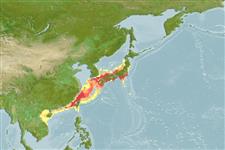Common names from other countries
>
Pleuronectiformes (Flatfishes) >
Cynoglossidae (Tonguefishes) > Cynoglossinae
Etymology: Cynoglossus: Greek, kyon = dog + Greek, odous = teeth + Greek, glossa = tongue (Ref. 45335).
Environment: milieu / climate zone / depth range / distribution range
Ecología
marino demersal; rango de profundidad 50 - 220 m (Ref. 75201), usually 100 - ? m (Ref. 75201). Temperate
Northwest Pacific: Japan.
Tamaño / Peso / Age
Maturity: Lm ? range ? - ? cm
Max length : 18.0 cm SL macho / no sexado; (Ref. 75201)
Short description
Claves de identificación | Morfología | Morfometría
This relatively small species is distinguished by the following characters: 3 continuous ocular side lateral lines (dorsolateral, midlateral and ventrolateral), none on the blind side; scales on cephalodorsal line 6-9, dorsolateral line 66-79, midlateral line 67-73, ventrolateral line 38-62; scales above dorsolateral line 3-4, between dorsolateral and midlateral lines 11-12; pored scales with well developed blackish posterior flap present on dorsolateral, midlateral, cephalodorsal and mandibulo-opercular lines; contiguous eyes; mouth no fringe, reaching posteriorly to vertical line at middle of lower eye; ocular side with 2 nostrils, the anterior nostrils developed, tubular; dorsal and anal fins with dark brown to blackish dapples; 104-112 dorsal-fin rays; 83-88 anal-fin rays; 10 caudal-fin rays; vertebrae 8-9+43-45=52-54; body uniformly brown; dorsal and anal fins dark brown to blackish, with dappled marks on ocular side, uniformly dense pigmentation on blind side (Ref. 75201).
Life cycle and mating behavior
Maturities | Reproducción | Spawnings | Egg(s) | Fecundities | Larva
Yokogawa, K., H. Endo and H. Sakaji, 2008. Cynoglossus ochiaii, a new tongue sole from Japan (Pleuronectiformes: Cynoglossidae). Bull. Natl. Mus. Nat. Sci. Ser. A. Suppl. 2:115-127. (Ref. 75201)
IUCN Red List Status (Ref. 130435)
CITES (Ref. 128078)
Not Evaluated
Threat to humans
Harmless
Human uses
Herramientas
Special reports
Download XML
Fuentes de Internet
Estimates based on models
Preferred temperature (Ref.
115969): 11 - 21.2, mean 18.8 (based on 40 cells).
Phylogenetic diversity index (Ref.
82804): PD
50 = 0.5000 [Uniqueness, from 0.5 = low to 2.0 = high].
Bayesian length-weight: a=0.01514 (0.00592 - 0.03870), b=3.00 (2.77 - 3.23), in cm Total Length, based on LWR estimates for this (Sub)family-body shape (Ref.
93245).
Nivel trófico (Ref.
69278): 3.4 ±0.4 se; based on size and trophs of closest relatives
Resiliencia (Ref.
120179): Alto, población duplicada en un tiempo mínimo inferior a 15 meses (Preliminary K or Fecundity.).
Fishing Vulnerability (Ref.
59153): Low vulnerability (12 of 100).
